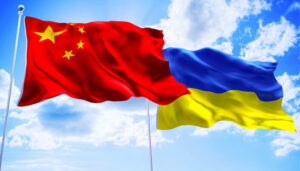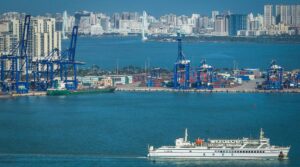
First Deputy Minister of Foreign Affairs of Ukraine Serhiy Kyslytsya discussed ways to strengthen trade and economic cooperation between the two countries with Deputy Minister of Foreign Affairs of China Liu Bin in Beijing.
“In Beijing, First Deputy Minister of Foreign Affairs Serhiy Kyslytsya held Ukrainian-Chinese political consultations with Assistant (Deputy) Minister of Foreign Affairs of the People’s Republic of China Liu Bin,” according to a statement from the press service of the Ministry of Foreign Affairs.
According to the report, the parties discussed topical issues on the bilateral agenda, outlined plans for further contacts at the highest and high levels, discussed ways to strengthen trade and economic cooperation, and issues of interaction within international organizations.
The interlocutors confirmed that mutual respect for sovereignty and territorial integrity is the foundation of Ukrainian-Chinese relations.
“There was an in-depth exchange of views on the current situation related to the ongoing armed aggression of the Russian Federation against Ukraine, as well as international efforts to achieve sustainable and lasting peace,” the statement said.
As part of his working visit to Beijing, Kislitsya also met with representatives of Chinese expert and analytical circles, as well as the diplomatic corps of partner countries.

Foreign direct investment (FDI) in mainland China’s economy in January-November 2025 fell 7.5% year-on-year to 693.18 billion yuan ($98.5 billion), according to the Ministry of Commerce.
The manufacturing sector attracted 171.72 billion yuan, while the services sector attracted 506.29 billion yuan.
Meanwhile, Switzerland’s FDI rose 67%, the UAE’s 47.6% and the UK’s 19.3%. FDI in November increased 26.1% year-on-year. As reported, FDI in 2024 collapsed 27.1% to 826.25 billion yuan. This is the maximum decline in the history of counting (since 2008).

On 18 December, the Chinese authorities introduced an independent customs regime for Hainan Island, which allows for freer importation of foreign goods and expands the range of products eligible for zero tariffs, according to Xinhua.
This is one of the most significant steps in China’s efforts to promote free trade and greater economic openness, the publication notes.
The island, which covers an area of more than 30,000 square kilometres, has been declared a special customs control zone. The business environment for foreign companies here will be more in line with international standards, with lower taxes and production costs, as well as expanded access to services, including healthcare and education. Businesses will be able to use Hainan as a platform to enter the huge mainland Chinese market, Xinhua notes.
The list of goods exempt from customs duties at the port of Hainan has been expanded from 1,900 to 6,600, and the share of such goods in total shipments will increase from 21% to 74%.
In addition, in accordance with current regulations, these goods can be shipped to mainland China after processing, creating added value of at least 30%.
Hainan became a special economic zone in China in 1988. According to official data, more than 9,600 new enterprises with foreign investment have been established in the province since 2020.
Hainan’s GDP last year was $113 billion, which is comparable to the world’s 70th largest economy, according to the World Bank.

Imports of electric batteries and separators to Ukraine in January–November 2025 increased by 52% compared to the same period last year and amounted to $1.232 billion, according to the State Customs Service.
China remains the main supplier, accounting for $900.2 million (73.2% of the total volume), followed by Vietnam ($96.7 million, 7.9%) and Taiwan ($54.2 million, 4.4%). For comparison, in 2024, China accounted for 83.2% of imports, while the Czech Republic and Bulgaria accounted for 2.8% and 2.7%, respectively.
In November 2025, battery imports grew by 43.6% compared to November 2024, reaching $177.7 million, which is also 22.6% higher than in October.
At the same time, Ukraine exported batteries worth $47.6 million, which is 26% more than a year earlier. The largest buyers were Poland (32.7%), Germany (13%), and France (11.5%).
The increase in imports of battery systems is explained by steady demand from energy companies, telecom operators, and household consumers, as well as the effect of state subsidies for battery imports, approved in July 2024.
By the end of 2024, total imports of batteries to Ukraine had more than doubled to $950.6 million, and in 2025, they continue to grow rapidly thanks to the modernization of the energy system and the development of the market for autonomous power sources.

Ukrainian President Volodymyr Zelensky said that “a weak Russia and a defeated Russia are not beneficial,” so he believes that China is not seeking an end to the Russian-Ukrainian war.
“Of course, China is a strong country with a strong economy, and most importantly in our case, it has influence over Russia, personally over Putin. But with all due respect to the Chinese people, their history, and their culture, we must honestly say that I don’t see how ending this war would benefit China. Why? Because, I think we have read… the new US (security) doctrine… These are two great powers, great economies, and this is a great confrontation. This does not mean that it is a war, it may be any diplomatic or economic confrontation – this is happening. And today, a weak Russia and a defeated Russia in this format is not beneficial to China.
And because of this, honestly, the Ukrainian people are suffering,“ Zelensky said, responding to a question from journalists on WhatsApp on Monday.
Zelensky added that if ”it is not beneficial for China to stop Russia, it means that the war will continue.”
“This does not mean that China directly supports Russia with weapons, but it certainly does not support stopping this war. That is final. Plus, there are various reports from our intelligence services about the supply of machine tools and other items from China to Russia, but I have not been informed of any direct supplies of weapons,” Zelensky said.